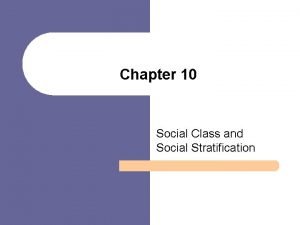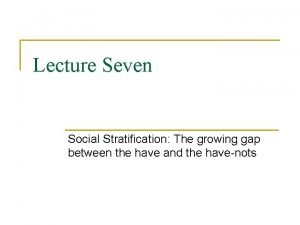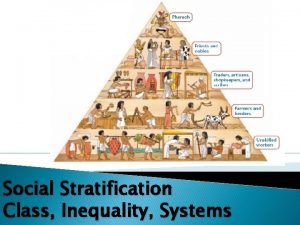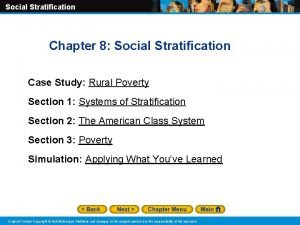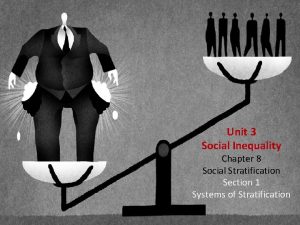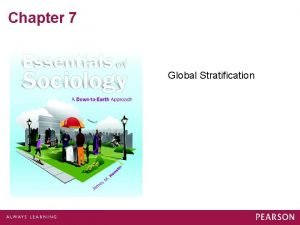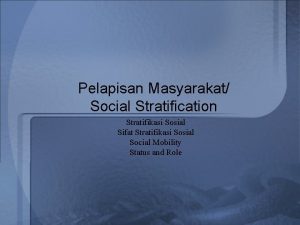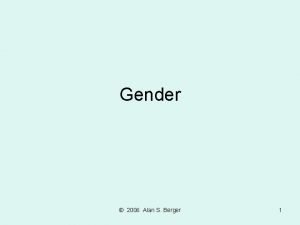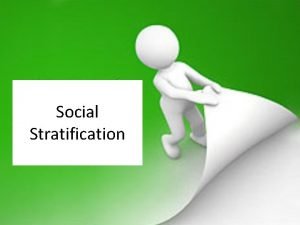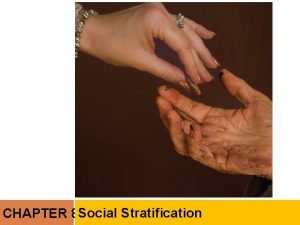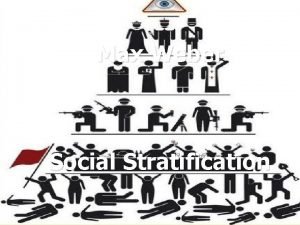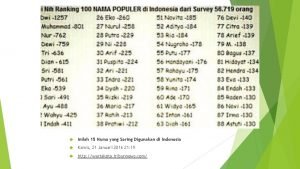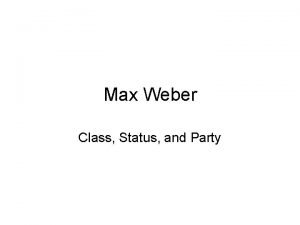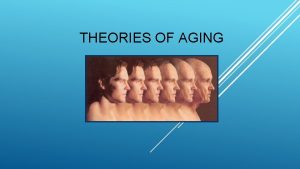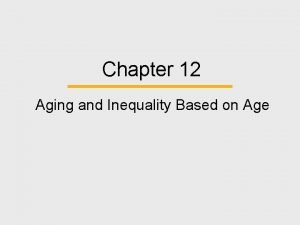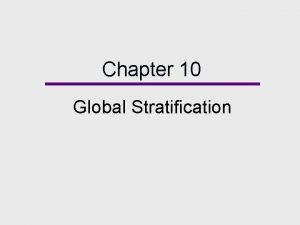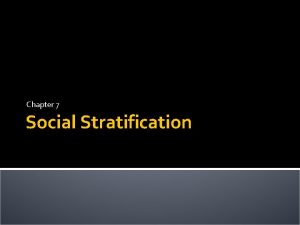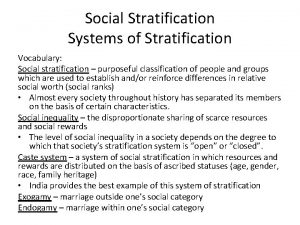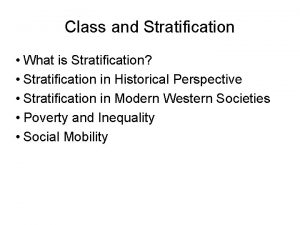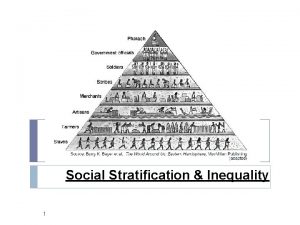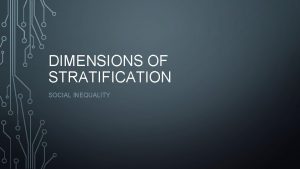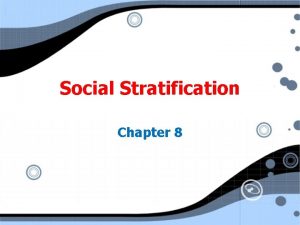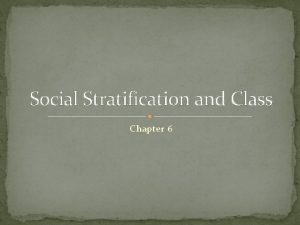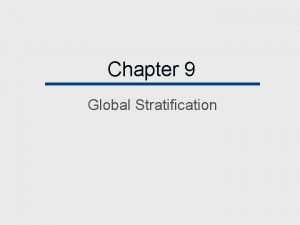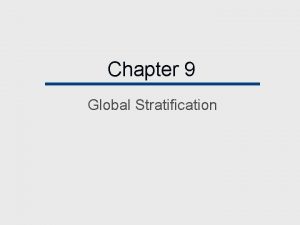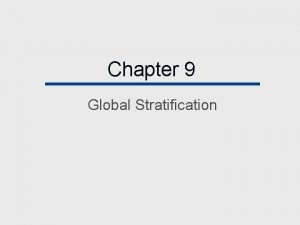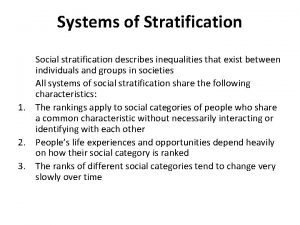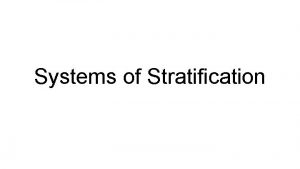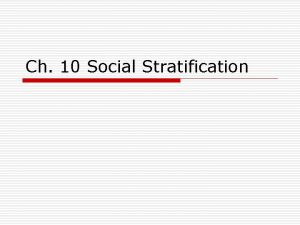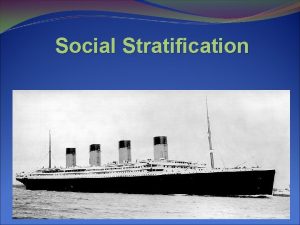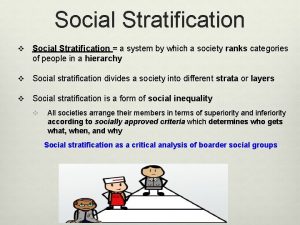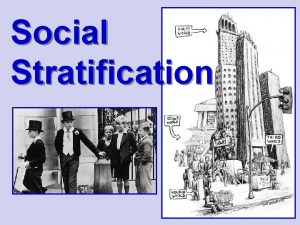Social Stratification Chapter 9 social stratification Systems of




























- Slides: 28

Social Stratification Chapter 9

§social stratification – Systems of Stratification division of society into categories, ranks, or classes §can be based on either achieved or ascribed status §can be open or closed

§social inequality – the unequal sharing of scarce resources and social rewards Systems of Stratification

Caste System: § Closed and lifelong Systems of Stratification § Immobility and inherited status § Based on specific occupations § Ascribed status § exogamy, endogamy

Class System: § Open and mobile Systems of Stratification § Reward is determined by achieved status § Property, prestige, and power are important (Weber) § bourgeoisie, proletariat


§ social class – grouping of people with similar levels of wealth, power, and prestige § wealth – made up of assets (value Systems of Stratification of everything one owns) and income (money earned through salaries, investments, or capital gains § in the U. S. the richest 1% of the population controls more than 1/3 of the wealth

§ power – the ability to control the behavior of others, with or without their consent § based on force, possession of special Systems of Stratification skills, knowledge, social status, personal characteristics, custom/tradition § prestige – respect, honor, recognition, or courtesy an individual receives from other members of society § based on income, occupation , education, family, residences, possessions, club memberships

§ socioeconomic status – SES, Systems of Stratification rating that combines social factors such as educational level, occupational prestige, residence, income, used to determine an individual’s relative position in the stratification system

§ Functionalist Theorists – view Systems of Stratification stratification as a necessary feature of the social structure and argue that the more important a role and the more skill needed to perform it, the higher the reward, without varying rewards may jobs would not be filled and society could not function

§ The Functionalist Theory fails to Systems of Stratification recognize not everyone has equal access to resources, ignores the talented in lower classes that because of stratification may not be able to contribute to society, cannot explain why rewards sometimes do not reflect the social value of a role

§Conflict Theorists – view Systems of Stratification stratification as a result of conflict over scarce resources and argue that groups gain power then use that power to maintain it, based on Marx §fails to recognize that unequal rewards are based on differences in talent, skill, and desire

§ open system § law forbids discrimination based The American Class System on ascribed characteristics such as race or gender § in theory, all have equal access to resources § rate of social mobility is not equal for all segments of society

Determining Social Class § reputational method – individuals are The American Class System asked to rank other community members based on what they know of their character and lifestyle § subjective method – individuals are asked to determine their own social rank § objective method – sociologists define social class by income, occupation, and education

The American Class System § 1% upper class § 14% upper-middle class § 30% lower-middle class § 30% working class § 22% working poor § 3% underclass §major difference in classes is income, lifestyle, beliefs

§ Upper Class – attend prestigious The American Class System universities; owners of large businesses, investors, heirs to family fortunes, top business executives; 1 percent of population § Upper Middle Class – attend college or university, business executives, professionals; 14 percent of population § Lower Middle Class – high school, some college; lower-level managers skilled craftworkers, supervisors; 30 percent of population

§ Working Class – high school The American Class System education; factory workers, clerical workers, lower level salespeople, some craft-workers; 30 percent of population § Working Poor – some high school; laborers, service workers; 22 percent of population § Underclass – some high school; undesirable, low-paying jobs, unemployed, on welfare; 3 percent of population

§social mobility – the movement between or within social classes or strata The American Class System § horizontal mobility – movement within a social class § vertical mobility – movement between social classes, upward or downward § intergenerational mobility – status differences between generations in the same family (parent’s social class vs. their own current class)

§ structural factors that affect The American Class System upward mobility include advances in technology, changes in merchandising patterns, and increase in education

Motivations and Cultural Values Influence the American Class System § Values influence Americans to try The American Class System to do better financially than their parents and to help their children do the same § Most Americans remain in the same social class as their parents

§ More than 31 million people Poverty (11% of the population) live below the poverty level. § poverty – a standard of living that is below the minimum level considered adequate by society, a relative measure § poverty level – defined by the U. S. Bureau of Census, the minimum annual income needed by a family to survive

Poverty Level: §determined by calculating the cost of providing an adequate diet, based on the U. S. Dept. of Agriculture’s minimum nutritional standards §this number is then multiplied by three (research has indicated that poor people spend 1/3 of their income on food) §adjusted each year to reflect the cost of living §usually stated for a family of 4

Poverty Groups Affected By Poverty § Age – children are the largest group (37%); three times more African American and Hispanic children are poor than whites § Gender – women are the largest segment (57%); female-headed households account for about half of all poor families § Race and Ethnicity – African Americans and Hispanics are far more likely than white Americans to be poor

§ Poor and wealthy members of society differ in the range of their life chances and behavior patterns. § life chances – the likelihood that individuals have Poverty of sharing in the opportunities and benefits of society § health, life expectancy, housing, education § the lower the social class, the less opportunity to share in the benefit of society § life expectancy – the average number of years a person born in a particular year can expect to live § inadequate nutrition and less access to medial care

§patterns of behavior §higher divorce rate §committing crime §people living in poverty Poverty are more likely to commit crimes that police pursue more aggressively §victims of crime

§ Government attempts to reduce Poverty inequality through various socialwelfare programs using two approaches: § Transfer Payments – redistribution of money among various segments of society; taking a percentage of the money collected through taxes and funneling it to groups that need public assistance (poor, unemployed, elderly, disabled

§ Supplemental Security Poverty Income (SSI): provides income support for people age 65 and older, the blind, and disabled with children § Temporary Assistance for Needy Families (TANF): cash payments to families with children

§ Subsidies - transfer goods and Poverty services rather than cash § Food Stamp Program: people receive coupons or cards that can be used to buy food § housing, school lunches § Medicaid: health insurance program for the poor § Medicare: governmentsponsored health insurance program for people 65 and older
 Social class max weber
Social class max weber Systems of social stratification
Systems of social stratification Social stratification vs social inequality
Social stratification vs social inequality Social stratification
Social stratification Chapter 8 social stratification
Chapter 8 social stratification Chapter 9 social stratification
Chapter 9 social stratification Causes of social mobility
Causes of social mobility Open and closed stratification systems
Open and closed stratification systems How do elites maintain stratification
How do elites maintain stratification Mixed social stratification
Mixed social stratification Social stratification in gender
Social stratification in gender Regular expression symbols
Regular expression symbols Social inequality examples
Social inequality examples American class system
American class system Supposedly definition
Supposedly definition Max weber social class
Max weber social class Definition of stratification
Definition of stratification Stratifikasi politik adalah pelapisan sosial berdasarkan
Stratifikasi politik adalah pelapisan sosial berdasarkan Mixed social stratification
Mixed social stratification Max weber party
Max weber party Chapter 4 ethical issues
Chapter 4 ethical issues 4 components of an information system
4 components of an information system Disengagement theory
Disengagement theory Global stratification definition
Global stratification definition Global stratification definition
Global stratification definition Stratification sociale
Stratification sociale Seed germination process
Seed germination process Age stratification
Age stratification Global stratification definition
Global stratification definition
